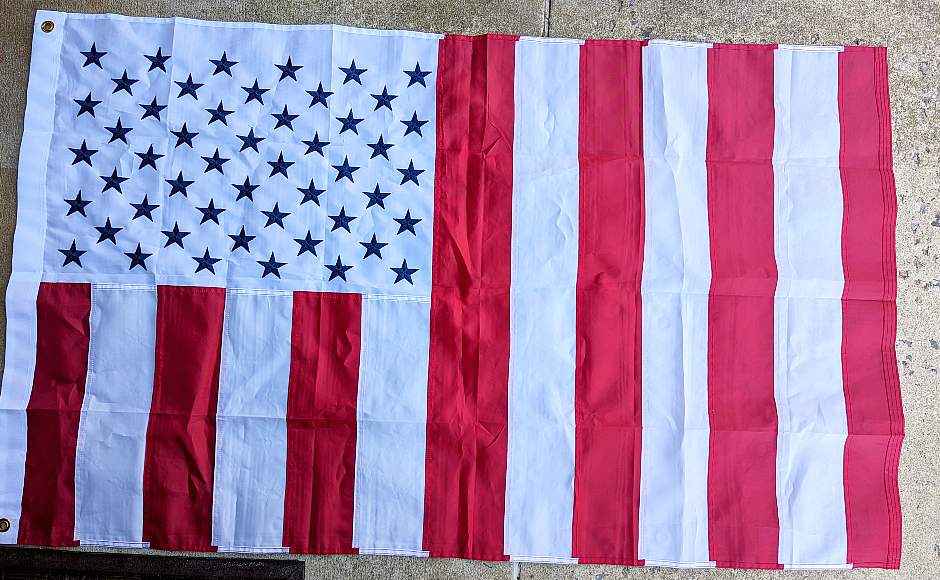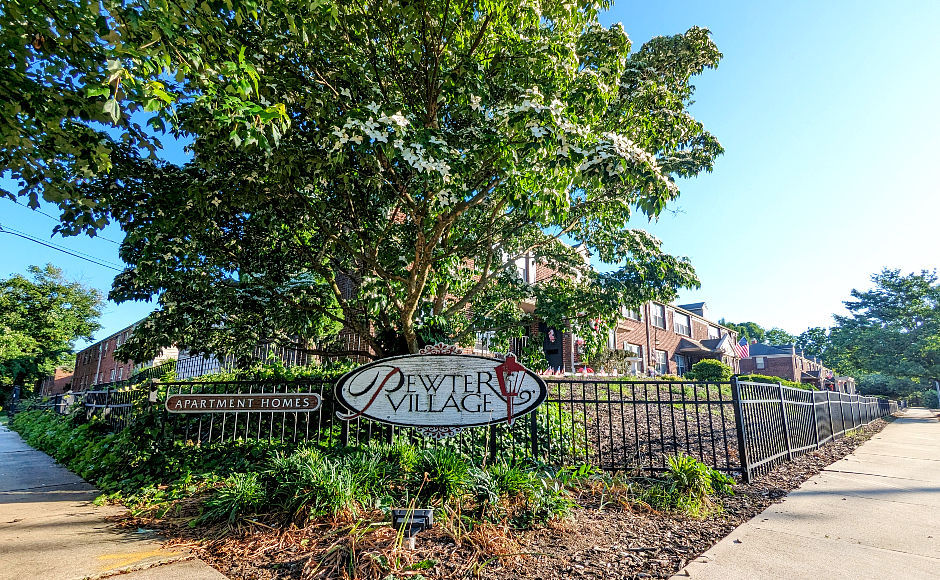Sometimes called ‘peacetime’ or ‘civil’ flags, they are often used by domestic extremists like the Sovereign Citizen movement. A maintenance manager at the Pewter Village says he made the switch ‘to bring light to another choice.’
By Matt Skoufalos | May 28, 2024
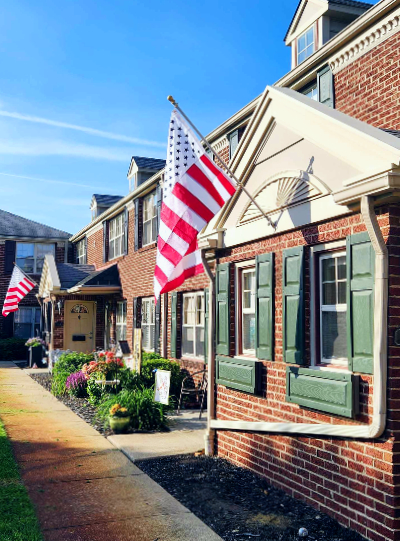
Homes at the Pewter Village Apartments saw their American flags replaced with an anti-government version last week. Credit: NJPEN.
Around the Memorial Day weekend, it’s quite common to see the American flag prominently displayed in commemoration of the nation’s war dead.
But on Thursday, residents of the Pewter Village Apartments in Collingswood awoke to discover that their flags had been replaced by a nonstandard variant.
Sometimes described as “the civil flag of peacetime” or the “civil flag,” it features 13 red and white vertical stripes offset by a white canton with blue stars.
Federal law has long established that “the flag of the United States shall be thirteen horizontal stripes, alternate red and white; and the union of the flag shall be forty-eight stars, white in a blue field.”
There is no other version of the American flag that is recognized by any U.S. government entity.
However, that hasn’t stopped myth-building around the so-called “civil flag,” especially among antigovernment groups.
Peter Loeser and James Ferrigan of the North American Vexillological Association, which bills itself “the world’s largest organization of flag enthusiasts and scholars,” described the origins of the “civilian flag” as a misidentification of a prior U.S. Customs Service flag that became folded into lore for conspiracy theorists.
“Basically, there never has been a different civilian version of the national flag, yet this urban legend continues to be believed by many,” Loeser and Ferrigan wrote.
“In conclusion, the urban legend of a civil flag continues to allow conspiracy theory enthusiasts fertile land to plow, and a chance to make a little money on the side by selling civil flags and buttons.”
For more than a few Pewter Village residents, the changeover was an unwelcome surprise.
They first got a letter on Wednesday, ostensibly from property managers, letting them know about the “Brand New, made here in the states, American peacetime flags.” It was stapled to a second, one-page document describing “it’s history, meaning and use.”
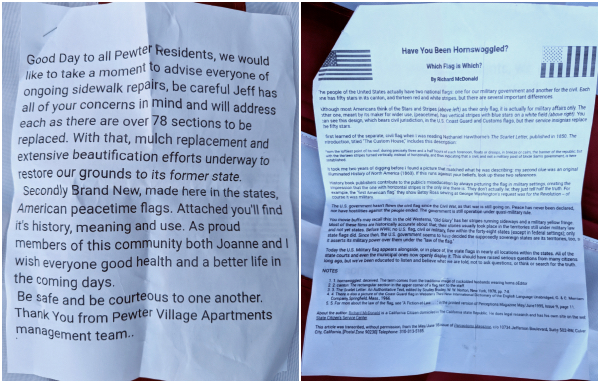
Left: a letter sent to Pewter Village residents by maintenance man Jeff Rappa. On the right, a reprint of a sovereign citizen explanation about the ‘peacetime flag.’ Credit: Matt Skoufalos.
That treatise, entitled “Have You Been Hornswoggled?” by Richard McDonald, has been reprinted in various forms since the 1990s, and even appears in The Anti-Government Movement Guidebook, a whitepaper produced by the National Center for State Courts, as an example of conspiratorial rhetoric catalogued in the wild.
McDonald’s letter begins with the premise that “the people of the United States actually have two national flags, one for our military government and another for the civil,” before finally concluding that “the government is still operation under quasi-military rule” because “peace has never been declared” after the U.S. Civil War.
Rationalizations such as these are commonly employed by antigovernment groups like the Sovereign Citizens, which the nonprofit Institute for Strategic Dialogue describes as being “frequently linked to conspiratorial and extremist beliefs.” Sovereign Citizens have been on the radar of the FBI for some 15 years for their attempts to skirt judicial and legal authority, run scams, and even commit violence.
McDonald himself attempted unsuccessfully to employ Sovereign Citizen arguments in federal court as a defense against paying federal income taxes. The U.S. Ninth Circuit Court of Appeals rejected his claim that “he is not a ‘person’ subject to federal tax laws; and Congress did not have the power to enact federal tax statutes because the Fourteenth Amendment was never properly ratified.”
‘No one was happy about it’
For all the talk of federal hornswoggling in the print-out accompanying the new flags, Pewter Village residents felt like they’d been misled by their landlords when they saw them flying on their homes.
One three-year resident of the property, who spoke on condition of anonymity, said they first noticed the change when they came home from work Thursday evening.
“No one was happy about it,” the resident said. “The people who live here are all senior citizens. They only know one flag. The American flag is one flag, to me.”
Another eight-year tenant of the property said they “didn’t care for it,” and specifically mentioned the poor timing of making the change during the Memorial Day holiday.
“People have died for this flag,” the tenant said.
A third renter complained to management about feeling anxious in the wake of the change.
“I am personally outraged and deeply saddened by this display, and I believe it falsely aligns all residents with the hateful rhetoric that now seems so readily accepted in our country,” they wrote.
“My general feeling of safety in the community is severely diminished. I implore you to reconsider the decision to display these flags, which are a symbol of hate and intimidation.”
Pewter Village resident Ron McKee, a U.S. Air Force veteran, said that his neighbors applauded when he pulled down the antigovernment flag and replaced it with an American flag.
“It’s not only a bad decision, it’s insulting and disrespectful,” McKee said. “I’ve never saluted anything like that; never saw anything like that on any base, courthouse, fire station, police station.
“When you do this on Memorial Day, and you have veterans living here, and people who have people who died serving their country, it’s egregious,” he said.
“This flag is supposed to unite us,” McKee said. “What it did to us was just insane. A lot of older people are upset.”
The decision to hang the replacement flags evidently was made solely by Pewter Village maintenance manager Jeff Rappa, who said he did so “to bring to light that there was another choice.”
However, property manager Joanna Delli Paoli said Rappa had told her the replacement flags were all he was able to obtain from his usual supplier before the holiday weekend.
“He told me that they didn’t have [American flags] in stock, and they gave him something else, and they sent him a whole brochure about it,” Delli Paoli said.
“We took them down because that is not the flag we’ve had up for the last 24 years,” she said.
Rappa, who said he’s worked and lived at the complex for 12 years, is just three months shy of retirement. He chose to hang the flags over the holiday weekend due to “the impending catastrophe [in which] our country finds itself.
“Our current status in country is that we have been hijacked by a corrupt government, and all can’t see it slowly picking up speed, going around and around down the toilet,” he said. “I pray every day for the world. I just would want a better place for our grandchildren, as would anyone.”
Rappa said he was surprised to learn that not only had several Pewter Village residents never heard of the “civilian peacetime flag,” but that some of them were “triggered” by his choice to replace their flags.
McKee could definitely be counted among that group. Both he and Rappa described having an altercation after the new flags went up, with Rappa upset that his flag had been taken down, and McKee furious that he had had to do so to begin with.
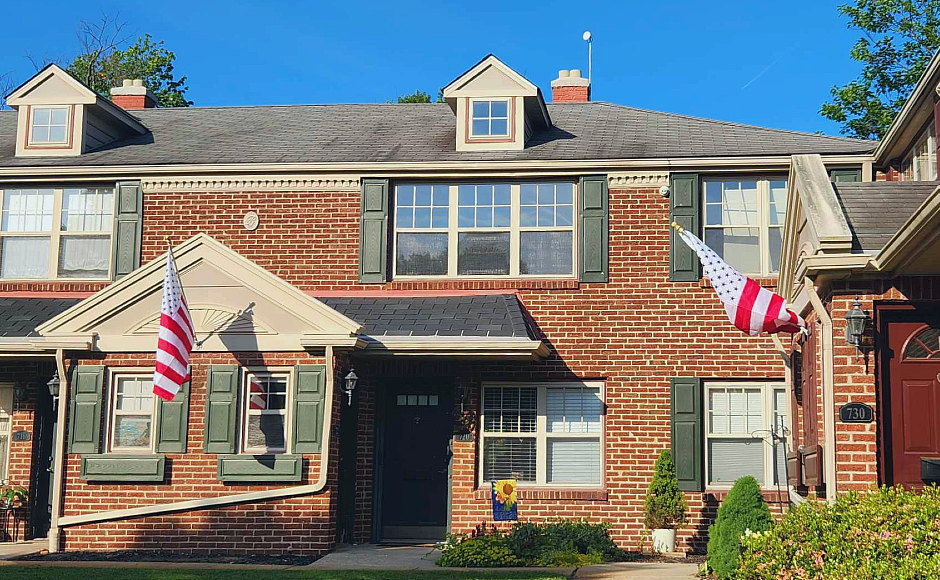
Homes at the Pewter Village Apartments saw their American flags replaced with an anti-government version last week. Credit: NJPEN.
“It would be nice if we could come together,” Rappa told NJ Pen over text message.
“It’s peaceful. Loving countrymen and women, and honor[ing] our vets as a civilian.”
In the end, one of the owners from the Sapphire Group, to which Pewter Village belongs, traveled to Collingswood from Lakewood to restore American flags to all the buildings onsite.
Rappa, who said he had ordered the “civilian peacetime flags” with a company credit card, was dismayed that his bosses had chosen to fly “Amazon-ordered Old Glory flags from somewhere.”
He had declined to change the flags back himself, saying that to do so after his encounter with McKee would be “humiliating and demeaning.”
“This wasn’t personal on any level,” Rappa said. “I am happy to fly my peacetime flag after I leave.”
McKee said some of what he most appreciates about Pewter Village is that generally, its neighbors don’t let their discussions turn political.
“What makes this place special is people keep this to themselves,” he said. “It’s over and done with now, and people are a lot happier. It’s a lesson learned.”

